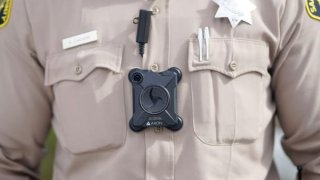
In a pilot program at Las Colinas Detention and Reentry Facility, in Santee, deputies began wearing body cameras last week, according to the San Diego County Sheriff's Department.
The first body cameras debuted last Friday at Las Colinas, which serves as the primary jail for women prisoners in San Diego County.
Seventy-two cameras were assigned to deputies, specialized units and supervisors within the facility, SDSO said.
"This is ultimately about the safety of the people in our custody and those who work in our facilities," Acting Sheriff Kelly Martinez said. "Having body cameras in our jails will also strengthen our relationship with the community by increasing accountability and trust."
Get San Diego local news, weather forecasts, sports and lifestyle stories to your inbox. Sign up for NBC San Diego newsletters.
A dedicated room was built at Las Colinas to house the docking stations for the body cameras, and significant upgrades were made to the electrical and network infrastructure around the jail to efficiently facilitate the charging and transfer of data.
Ongoing surveys are being collected from those participating in the program, according to deputies. The feedback will improve policies and procedures and identify best practices for training, and will lead to necessary adjustments to operations and security as this program is phased into other jails.
Body-worn cameras were implemented in San Diego County Sheriff's Department patrol operations in 2017, according to SDSO
Local
"It has always been the goal to include detentions operations, and this pilot program will be expanded to all facilities as the infrastructure is built out," a department representative said.
Additionally, deputies said, video footage could provide critical evidence for the investigation of incidents and the resolution of complaints. Body-worn cameras will supplement stationary cameras and other systems at detention facilities.
SDSO said, because jails are not public spaces, there are specific guidelines for when a deputy may turn the camera on and off with respect to an inmate's rights and privacy. Among them are:
- Any movements or escorts of incarcerated persons from one area to another (cell movements, between housing modules, holding cells, visitation, courts, from intake or to final release, etc.)
- Entering a cell, dormitory housing or holding area occupied by an incarcerated
person - During the intake and booking process
- Searches of any housing areas, cells, dorms, etc.
- While supervising any incarcerated workers
- While placing or removing an incarcerated person into or from a transport vehicle for any purpose including but not limited to movement between facilities, courts, or to the hospital



